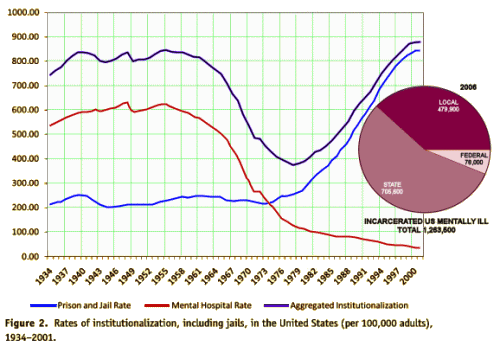-
"and this graph suggests that the patients essentially moved next door into our prisons"
-
" If there is ever a place where the parable of the blind men and the elephant fits like a glove, this is it"
-
"I begin to wonder about diagnosis. How many have psychotic illnesses? Are these the homeless chronic patients who have been picked up for minor crimes? How many are primarily substance abusers?"
-
"the time for decrying, blaming, or ignoring this has passed"
-
"This effort should be lead by the National Institute of Mental Health and the Substance Abuse and Mental Health Services Administration"
I posted a couple of graphics [what they’re for…] that paint the picture that chronic mental patients are being warehoused in correctional facilities because there’s no place else for them to go in the post-deinstitutionalization era. I believe that and I don’t think it’s a good thing. But I don’t really know how accurate those figures are and I really don’t know what the people who compiled those figures consider chronic mental illness. How much is substance abuse? How much is chronic psychosis? The figures I found are mostly compiled by the correctional institutions and subject to the bias of their feeling overwhelmed. In the comments to the last post, those questions were raised. We need accurate information, which is the only way to really understand the magnitude of this problem. And in-so-far as I can see, we don’t have it. And because of the variability of our states and state governments, it has to be a national information gathering for any accuracy.

When I read about it, there’s way too much "it has been estimated…" This is something we need to know, not estimate. And it’s science, epidemiology is what it’s called. And who should gather that kind of information? The CDC? The NIMH? SAMHSA? I expect they all have some version of that information, but it lags and if it’s in a usable form, I can’t locate it. That’s why I say, "This effort should be lead by the National Institute of Mental Health and the Substance Abuse and Mental Health Services Administration" [see #5]. Our NIMH has chased the very shaky World Health Organization data about the prevalence of mental illness and dire predictions of the future. But they’ve largely ignored this problem. And they haven’t taken the first step, defining the magnitude and nature of the problem. They’ve spent their time preoccupied with neuroscience and the monocle of psychopharmacology. The state of chronic mental health care in the US is the number one scientific question on the mental health table and prison is the logical place to start. In the comments, George Dawson says that the NIMH is a bad choice because it is a basic science organization. I happen to think epidemiology is a basic science par excellence. Likewise, the CDC, our traditional infectious disease tracker, needs to join in the gathering and tracking mainly because of proven expertise. The fact that we don’t know the magnitude and nuances of this problem is to our shame, all of us – thus Dr. Frances’ title " The Hall of Shame – Who Is Failing the Severely Ill?" [see #1, #3, #5].
The essence of science is to find out answers, or the best answers, to things we don’t know. We [human-kind] don’t know how to deal with chronic psychosis effectively, and we never have. We thought we had at least separated the problem of chronic psychosis from antisocial behavior and criminality, but the charts above suggest that even that was not a solid conclusion. So I personally think we need to start where we are rather that indulge our natural propensity to ignore problems we don’t know what to do with, to blame the state of affairs on each other, or to self-righteously decry how things are without taking action [see #4].
Sorry, the comment form is closed at this time.